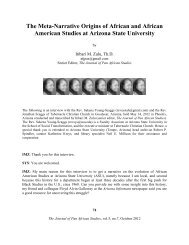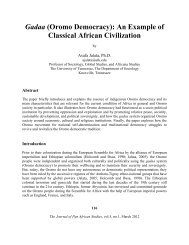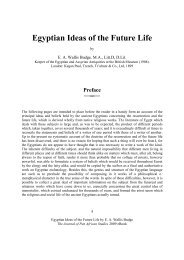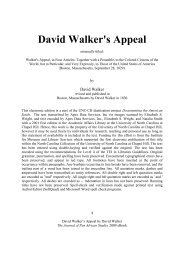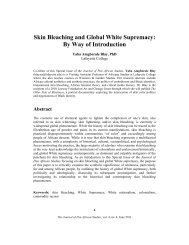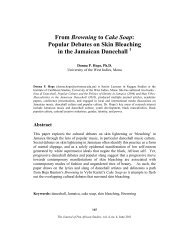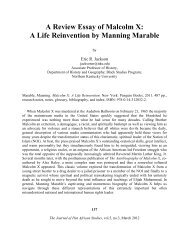The Kilumi Rain Dance in Modern Kenya - Journal of Pan African ...
The Kilumi Rain Dance in Modern Kenya - Journal of Pan African ...
The Kilumi Rain Dance in Modern Kenya - Journal of Pan African ...
You also want an ePaper? Increase the reach of your titles
YUMPU automatically turns print PDFs into web optimized ePapers that Google loves.
<strong>The</strong> bodies <strong>of</strong> the dancers become vessels symboliz<strong>in</strong>g the forthcom<strong>in</strong>g presence <strong>of</strong> the ra<strong>in</strong><br />
dance spirit. With<strong>in</strong> m<strong>in</strong>utes, spirits arrive <strong>in</strong> the ritual space danc<strong>in</strong>g and assess<strong>in</strong>g the situation.<br />
In the case <strong>of</strong> favor, the community is healed, moved from the former state to one <strong>of</strong> balance.<br />
<strong>The</strong> ra<strong>in</strong> spirit allows the heal<strong>in</strong>g <strong>of</strong> the entire community with the ultimate goal <strong>of</strong> generat<strong>in</strong>g<br />
ra<strong>in</strong>. 51<br />
Celebration<br />
<strong>The</strong> celebration phase was added to represent the closure <strong>of</strong> a positive ra<strong>in</strong> dance ritual<br />
ceremony. 52 With the eventual revitalization <strong>of</strong> the environment with ra<strong>in</strong>, no matter when it<br />
arrives, the entire community celebrates. Turner describes this f<strong>in</strong>al phase as one where the<br />
passage is complete, “<strong>The</strong> ritual subject, <strong>in</strong>dividual or corporate, is <strong>in</strong> a relatively stable state<br />
once more and, by virtue <strong>of</strong> this, has rights and obligations…he is expected to behave <strong>in</strong><br />
accordance with certa<strong>in</strong> customary norms and ethical standards.” 53 <strong>The</strong> celebration phase<br />
represents the end <strong>of</strong> the ritual and appreciation <strong>of</strong> favorable results. Aga<strong>in</strong>, it is important to<br />
note that the ra<strong>in</strong> dance ritual is symbolic on two levels. It represents the heal<strong>in</strong>g <strong>of</strong> the<br />
<strong>in</strong>dividual and the community, and it represents future fertility <strong>in</strong> crop production. At this po<strong>in</strong>t,<br />
the community usually s<strong>in</strong>gs, dances, and celebrates the arrival or the com<strong>in</strong>g <strong>of</strong> the ra<strong>in</strong>. Many<br />
may question the relationship between the ra<strong>in</strong> mak<strong>in</strong>g dance ceremonies and the arrival <strong>of</strong> ra<strong>in</strong>,<br />
but the po<strong>in</strong>t is too fluid to prove and irrelevant. What matters is what the Akamba th<strong>in</strong>k they<br />
accomplished and their faith <strong>in</strong> their prayers, songs, movements, and drums to br<strong>in</strong>g forth ra<strong>in</strong>.<br />
<strong>Ra<strong>in</strong></strong> <strong>Dance</strong> Socio-Cultural Implications<br />
<strong>Ra<strong>in</strong></strong> dance rituals <strong>in</strong> <strong>Kenya</strong> reveal some very important socio-cultural functions that may<br />
be applied to rituals <strong>in</strong> general. <strong>The</strong>re are also functions that are very specific to the ra<strong>in</strong> ritual.<br />
<strong>The</strong> functions identified will be framed aga<strong>in</strong>st the analysis <strong>of</strong> Tribhuwan who consolidated<br />
ritual functions from some <strong>of</strong> the top scholars on the topic. 54 (1) <strong>The</strong> ra<strong>in</strong> mak<strong>in</strong>g dance presents<br />
an excellent example <strong>of</strong> how dance fosters cohesion and community togetherness. <strong>The</strong> drought<br />
created a crisis <strong>in</strong> which the community needed to work together. (2) <strong>The</strong> ra<strong>in</strong> mak<strong>in</strong>g dance<br />
ritual was <strong>in</strong>strumental <strong>in</strong> the movement <strong>of</strong> the community from a state <strong>of</strong> affliction to a state <strong>of</strong><br />
heal<strong>in</strong>g. <strong>The</strong> ritual symbolically represented the universal movement <strong>of</strong> the community from a<br />
state <strong>of</strong> sickness to one <strong>of</strong> good health and good stand<strong>in</strong>g. (3) <strong>The</strong> ra<strong>in</strong> mak<strong>in</strong>g dance ritual<br />
shows spiritual <strong>in</strong>tervention. 55 <strong>The</strong>refore, rituals can be applied to resolve conflict <strong>in</strong> the society.<br />
(4) <strong>The</strong> ra<strong>in</strong> mak<strong>in</strong>g dance ritual expresses Akamba socio-cultural beliefs and mean<strong>in</strong>gs <strong>of</strong> the<br />
society.<br />
183<br />
<strong>The</strong> <strong>Journal</strong> <strong>of</strong> <strong>Pan</strong> <strong>African</strong> Studies, vol.4, no.6, September 2011



